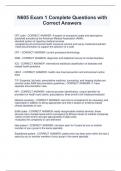N605 Exam 1 Complete Questions with
Correct Answers
CPT code - CORRECT ANSWER- A system of procedure codes and descriptions
published annually by the American Medical Association (AMA);
standard system of reporting medical services
-accepted by all commercial health insurance carriers and req by medicare/medicaid
-need documentation to support the selection of a code
CPT - CORRECT ANSWER- current procedural terminology
DSM - CORRECT ANSWER- diagnostic and statistical manual of mental disorders
ICD - CORRECT ANSWER- international statistical classification of diseases and
related health problems
HEAT - CORRECT ANSWER- health care fraud prevention and enforcement action
team
T/F: Surgeries, lab tests, preventative medicine, counseling, and imaging studies are
covered under E&M documentation guidelines - CORRECT ANSWER- F: have
separate documentation rules
NPI - CORRECT ANSWER- national provider identification; unique identifier for
providers for health care claims, prescriptions. Must enroll to bill medicare/medicaid
Medical necessity - CORRECT ANSWER- care that is considered to be necessary and
reasonable in addition to being appropriate care that is based on evidence-based
clinical standards of care
E&M codes - CORRECT ANSWER- easily recognizable medical services; these
services have multiple levels which correspond to different levels of medical complexity
-select correct level to be paid appropriately (5 digit code)
-evaluates the complexity of care delivered
New patient - CORRECT ANSWER- not been seen for 3 years by you or another
member of your group in the same speciality
Established patient - CORRECT ANSWER- patient who has been seen within the last 3
years by you or another member of your group in the same specialty
,Selecting the correct level of code depends on documenting what 3 key elements of the
visit? - CORRECT ANSWER- History
PE
Medical decision-making
(new patients require all 3 elements, established require 2 of 3)
E&M: New patient - CORRECT ANSWER- a patient who has not been seen for 3 years
by you or another member of your
group in the same specialty
E&M: Established patient - CORRECT ANSWER- a patient who has been seen within
the last 3 years by you or another member of your group in the same specialty
Documenting Hx - CORRECT ANSWER- CC/HPI, PFSH, ROS and categorized as
problem focused, expanded problem focused, detailed, and comprehensive
Problem- focused hx - CORRECT ANSWER- chief complaint, brief history of present
illness or problem (1-3 elements)
Expanded problem focused hx - CORRECT ANSWER- chief complaint, brief history of
present illness (1-3), system review relevant to patient's problems
Detailed hx - CORRECT ANSWER- chief complaint; extended (>4 elements) history of
present illness; system review relevant to patient's problem(s) and extended to include
review of limited number of additional systems (2-9 systems or pertinent positive and
neg findings); relevant past, family, or social history directly related to patient's
problem(s)
Comprehensive hx - CORRECT ANSWER- chief complaint; extended (>4) history of
present illness; review of systems directly related to patient's problem(s) extended to
include review of all additional body systems (at least 10); complete past, family, and
social history
Problem focused physical exam - CORRECT ANSWER- a limited examination of the
affected body area or organ system (1 or more)- 1-5 bullets documented
Expanded problem focused PE - CORRECT ANSWER- a limited examination of the
affected body area or organ system (1 or more)-at least 6 bullets
and other symptomatic or related organ systems
Detailed PE - CORRECT ANSWER- an extended examination of the affected body
area(s) or organ system and other symptomatic or related organ system(s)
-at least 6 or more organ systems; at least 2 bullet items per system; at least 12 bulleted
elements in 2 or more systems
, Comprehensive PE - CORRECT ANSWER- a general multi-system examination, or a
complete examination of a single organ system
According to Documentation Guidelines (1997), a detailed examination should include
at least six body areas or organ systems, and a comprehensive examination should
include at least nine.
-at least 2 bullets/system
Medical decision making - CORRECT ANSWER- refers to the complexity of
establishing a diagnosis and/or selecting a management option based on the following
factors:
-The number of possible diagnoses and/or the number of management options that
must be considered.
-The amount and/or complexity of medical records, diagnostic tests, and other
information that must be obtained, reviewed, and analyzed.
-The risk of significant complications, morbidity, mortality, or co-morbidities/underlying
diseases
associated with the patient's presenting problem(s), the diagnostic procedure(s), and/or
the possible management options.
What are the 4 levels of complexity of medical decision making? - CORRECT
ANSWER- Straightforward
Low complexity
Moderate complexity
High complexity
# of dx or tx options- doc the problem as: - CORRECT ANSWER- self limiting or minor
established, stable or improved
established, worsening
new, no additional workup
new, additional workup planned
amount/complexity of data to be reviewed, consider tests: - CORRECT ANSWER- Lab
tests, radiology tests, EKG, discussing test results with the MD, obtaining old records,
reviewing old records
Incident to billing - CORRECT ANSWER- services billed at 100% of the MD fee if
certain requirements are met
-under supervision of MD, immediately available
-no new problems diagnosed
NP reimbursement - CORRECT ANSWER- 85% of the physician fee
Steps to E&M coding - CORRECT ANSWER- 1. ID category and sub-category (Ex.
office visit, new patient)
2. determine extent of hx obtained
3. determine extent of exam performed




